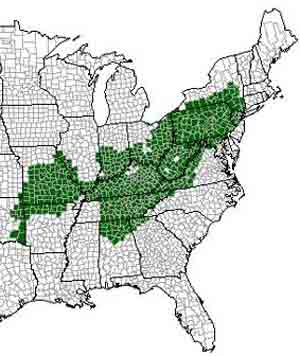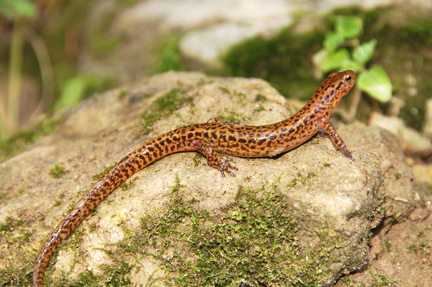
Longtail Salamander
(Eurycea longicauda)
 |
 |
|
|
Distribution of the Longtail Salamander (from the AR MI Atlas)
|
An adult Longtail Salamander (click for larger image).
|
|
Description: One of Ohio’s longest salamanders, the tail of this aptly named animal comprises 60-65% of its total length (up to 9”). The ground color is usually some shade of yellow or orange, but may be brownish in some individuals. Unlike the closely related Cave Salamander, the black spots on the Long-tailed Salamander are usually arranged into weak rows and form bars on either side of the distal portion of the tail. |
||
Distribution in Ohio: Southwestern and eastern Ohio. |
||
|
|
||
Status in Ohio: The Long-tailed Salamander is not a state listed species. |
||
|
|
||
Habitat: Streams, springs, seeps, caves, and wet shale banks are the primary habitats of the Long-tailed Salamander. Here they are most often found adjacent to or in shallow water, under rocks, logs, or within rock crevices. They are sometimes found some distance from water, in surrounding forest habitats. |
||
|
|
||
Life history: Breeding presumably occurs in late autumn and early winter. Eggs are laid in the winter, but are rarely found, probably because they are attached to rocks in dark, subsurface streams or seepages. The aquatic larvae hatch in 4-12 weeks and probably complete metamorphosis in the same year, although some may remain as larvae until the following spring or summer. |
||
|
|
||
Conservation: Populations of Long-tailed Salamanders are most threatened by destruction, disturbance, or pollution of their small aquatic habitats, including headwater streams, springs, and seeps. Pollution, runoff, and stream channelization and scouring are all major threats to these habitats in Ohio. |
||
Last modified:
|
Ohio Amphibians · Ohio Salamander Web · Ohio Salamander Species · Amphibian Habitats · Salamander Monitoring |
|